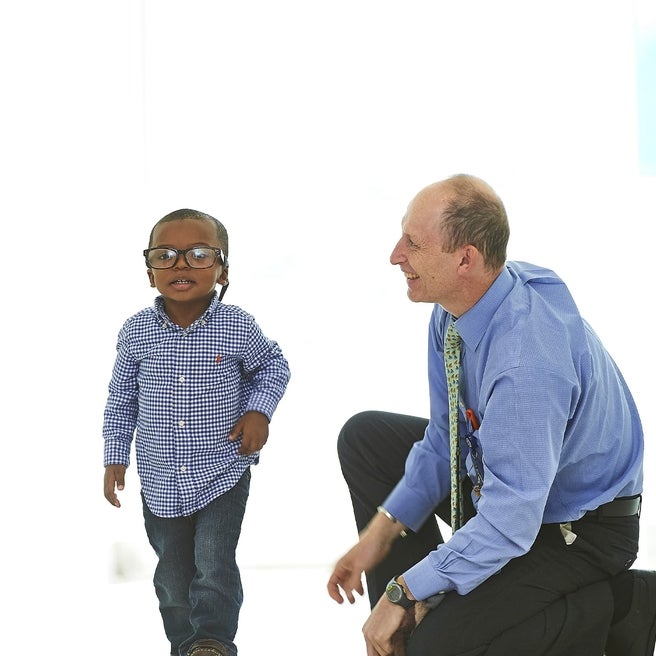What is childhood glaucoma?
Glaucoma is a condition in which the normal fluid pressure inside the eyes (intraocular pressure, or IOP) slowly rises as a result of the fluid aqueous humor - which normally flows in and out of the eye - not being able to drain properly. Instead, the fluid collects and causes pressure damage to the optic nerve (a bundle of more than 1 million nerve fibers that connects the retina with the brain) and loss of vision. Glaucoma is classified according to the age of onset. Glaucoma that begins before the child is 3 years old is called infantile or congenital (present at birth) glaucoma. Glaucoma that occurs in a child is called childhood glaucoma.
What causes childhood glaucoma?
Glaucoma occurs when the fluid drainage from the eye is blocked by abnormal development or injury to the drainage tissues, thus, resulting in an increase in the intraocular pressure, damage to the optic nerve, and loss of vision.
There are many causes of childhood glaucoma. It can be hereditary or it can be associated with other eye disorders. If glaucoma cannot be attributed to any other cause, it is classified as primary. If glaucoma is a result of another eye disorder, eye injury, or other disease, it is classified as secondary.
How is childhood glaucoma diagnosed?
In addition to a complete medical history and eye examination of your child, diagnostic procedures for childhood glaucoma may include:
-
visual acuity test - the common eye chart test (with letters and images), which measures vision ability at various distances.
-
pupil dilation - the pupil is widened with eyedrops to allow a close-up examination of the eye's retina and optic nerve.
-
visual field - a test to measure a child's side (peripheral) vision. Lost peripheral vision may be an indication of glaucoma.
-
tonometry - a standard test to determine the fluid pressure inside the eye.
Younger children may be examined with hand-held instruments, whereas older children are often examined with standard equipment that is used with adults. An eye examination can be difficult for a child. It is important that parents encourage cooperation. At times, the child may have to be examined under anesthesia, especially young children, in order to examine the eye and the fluid drainage system, and to determine the appropriate treatment.
What are the symptoms of childhood glaucoma?
Glaucoma is rare in children, as compared to the adult. However, when it does occur, the symptoms may not be as obvious in children. Many children are diagnosed before they are 6 months old. Glaucoma can affect one eye or both.
The following are the most common symptoms of childhood glaucoma. However, each child may experience symptoms differently. Symptoms may include:
-
excessive tearing
-
light sensitivity (photophobia)
-
closure of one or both eyes in the light
-
cloudy, enlarged cornea (large eye)
-
one eye may be larger than the other
-
vision loss
If the eye pressure increases rapidly, there may be pain and discomfort. Parents may notice that the child becomes irritable, fussy, and develops a poor appetite. Early detection and diagnosis is very important to prevent loss of vision. The symptoms of glaucoma may resemble other eye problems or medical conditions. Always consult your child's physician for a diagnosis.
Treatment for glaucoma
Specific treatment for glaucoma will be determined by your child's physician based on:
-
your child's age, overall health, and medical history
-
extent of the disease
-
your child's tolerance for specific medications, procedures, or therapies
-
expectations for the course of the disease
-
your opinion or preference
It is important for treatment of childhood glaucoma to start as early as possible. Treatment may include:
-
medications
Some medications cause the eye to produce less fluid, while others lower pressure by helping fluid drain from the eye. -
conventional surgery
The purpose of conventional surgery is to create a new opening for fluid to leave the eye. -
surgery
Surgical procedures are performed by using microsurgery or lasers. The purpose of surgery is to create an opening for fluid to leave the eye. Surgical procedures used to treat glaucoma in children include the following:-
trabeculotomy and goniotomy
A surgical opening is made into the drainage area of the eye (known as the trabecular meshwork drainage system), therefore establishing a more normal anterior chamber angle that allows the fluid to drain more freely, lowering the intraocular pressure (IOP). A goniotomy is an internal trabeculotomy procedure that is used in congenital glaucoma. -
trabeculectomy
A surgical procedure that involves the removal of part of the trabecular meshwork drainage system, allowing the fluid to drain from the eye. -
iridotomy
In this procedure, a small hole is made through the iris - the colored part of the eye - to allow fluid to flow more freely in the eye. The surgeon may use a laser to create this hole (laser iridotomy). -
cyclophotocoagulation
A procedure that uses a laser beam to freeze selected areas of the ciliary body - the part of the eye that produces aqueous humor - to reduce the production of fluid. This type of surgery may be performed with severe cases of childhood glaucoma.
-
Both medications and surgery have been successfully used to treat childhood glaucoma.
Resources to help
Childhood Glaucoma Resources
Division of Ophthalmology Resources
We have collected helpful resources on pediatric eye care so you can feel confident in the care you're providing your child.
